Pinus canariensis
Pinus canariensis, the Canary Island pine, is a species of gymnosperm in the conifer family Pinaceae. It is a large, evergreen tree, native and endemic to the outer Canary Islands of the Atlantic Ocean.
| Pinus canariensis Canary Island pine | |
|---|---|
 | |
| Canary Island pines in Caldera de Taburiente, La Palma | |
| Scientific classification | |
| Kingdom: | Plantae |
| Clade: | Tracheophytes |
| Clade: | Gymnosperms |
| Division: | Pinophyta |
| Class: | Pinopsida |
| Order: | Pinales |
| Family: | Pinaceae |
| Genus: | Pinus |
| Subgenus: | P. subg. Pinus |
| Section: | P. sect. Pinus |
| Subsection: | Pinus subsect. Pinaster |
| Species: | P. canariensis |
| Binomial name | |
| Pinus canariensis | |
Description
Pinus canariensis is a large evergreen tree, growing to 30–40 metres (98–131 feet) tall and 100–120 centimetres (39–47 inches) diameter at breast height, exceptionally up to 60 m (200 ft) tall and 265 cm (104 in) diameter.[3] The green to yellow-green leaves are needle-like, in bundles of three, 20–30 cm (8–12 in) long,[3] with finely toothed margins and often drooping. A characteristic of the species is the occurrence of glaucous (bluish-green) epicormic shoots growing from the lower trunk, but in its natural area this only occurs as a consequence of fire or other damage. The cones are 10–18 cm (4–7 in) long, 5 cm (2 in) wide,[3] glossy chestnut-brown in colour and frequently remaining closed for several years (serotinous cones). Its closest relatives are the chir pine (P. roxburghii) from the Himalayas, the Mediterranean pines P. pinea, P. halepensis, P. pinaster and P. brutia from the eastern Mediterranean.
Taxonomy
Pinus canariensis was first described in 1825 by Augustin Pyramus de Candolle, who attributed the name to Christen Smith.[2][4] It has been placed in subsection Pinaster of subgenus Pinus, section Pinus. The other species in the subsection are mainly Mediterranean in distribution, with one species (P. roxburghii) from the Himalayas.[5]
Distribution and habitat
The species is native and endemic to the outer Canary Islands (Gran Canaria, Tenerife, El Hierro and La Palma).[3] It is a subtropical pine and does not tolerate low temperatures or hard frost, surviving temperatures down to about −6 to −10 °C (21 to 14 °F). Within its natural area, it grows under extremely variable rainfall regimes, from less than 300 millimetres (12 in) to several thousands, mostly due to differences in mist-capturing by the foliage. Under warm conditions, this is one of the most drought-tolerant pines, living even with less than 200 mm (8 in) of rainfall per year.
The native range has been somewhat reduced due to over-cutting so that only the islands of Tenerife, La Palma and Gran Canaria still have large forests. Really big trees are still rare due to past over-cutting.[1] It is the tallest tree in the Canary Islands.
Fossil record
Fossils of Pinus canariensis have been described from the fossil flora of Kızılcahamam district in Turkey which is of early Pliocene age.[6] Fossil cones including seeds of Pinus canariensis are known from the late Miocene of Abkhazia, from the Vienna Basin and the Canary Islands. Numerous cone casts including seeds of Pinus canariensis from the early Pleistocene, were recovered on Kallithea, Rhodes.[7]
Ecology
This pine is one of the most fire-resistant conifers in the world, due to several beneficial adaptations.[8][9][10] In particular, Pinus canariensis is one of the few pine species that can epicormically resprout after losing its needles in a fire.[11]
Uses
The tree's extremely long needles make a significant contribution to the islands' water supply, trapping large amounts of condensation from the moist air coming off the Atlantic with the prevailing north eastern wind (locally called "alisios"). The condensation then drops to the ground and is quickly absorbed by the soil, eventually percolating down to the underground aquifers.
The aromatic wood, especially the heartwood, is among the finest of pine woods, being hard, strong and durable.
In mainland Spain, South Africa, Sicily and Australia, it has become a naturalized species from original landscape uses.
Pinus canariensis is a popular ornamental tree in warmer climates, such as in private gardens, public landscapes, and as street trees in California.
Gallery
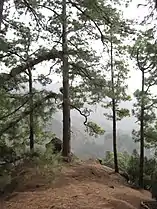 In natural habitat on Canary Islands
In natural habitat on Canary Islands Trunk
Trunk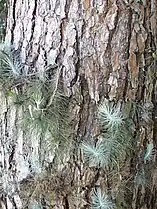 Epicormic shoots
Epicormic shoots_in_Presa_de_las_Ni%C3%B1as_02_(cropped).jpg.webp) A cluster of mature male cones of a Pinus canariensis in Gran Canaria
A cluster of mature male cones of a Pinus canariensis in Gran Canaria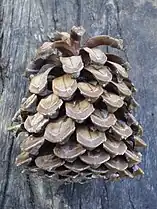 Mature opened female cone
Mature opened female cone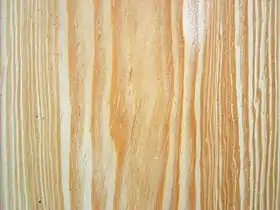 Figure on timber
Figure on timber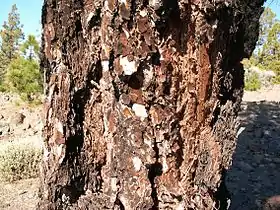 Fire-resistant trunk
Fire-resistant trunk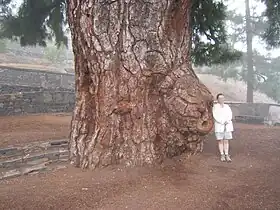 Vilaflor, Tenerife
Vilaflor, Tenerife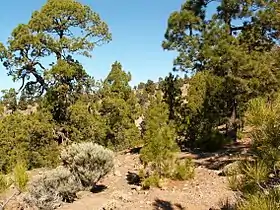 Tenerife south
Tenerife south_01_ies.jpg.webp) Pinus canariensis, Santa Cruz
Pinus canariensis, Santa Cruz Pinus canariensis forest, La Palma
Pinus canariensis forest, La Palma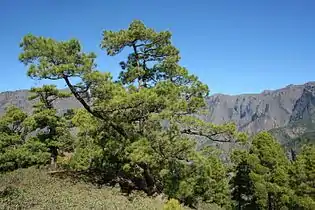 Pinus canariensis Caldera de Taburiente
Pinus canariensis Caldera de Taburiente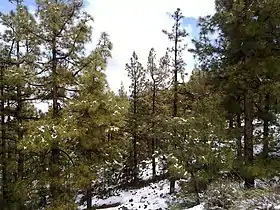 Tenerife
Tenerife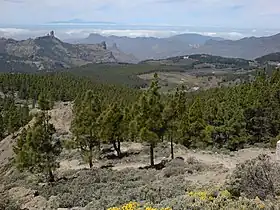 Gran Canaria
Gran Canaria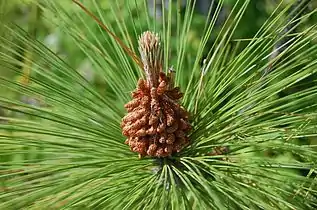 Male cones of Pinus canariensis photographed in Temecula, CA, USA
Male cones of Pinus canariensis photographed in Temecula, CA, USA Ayacata, San Bartolomé de Tirajana, Gran Canaria, Canary Islands, Spain.
Ayacata, San Bartolomé de Tirajana, Gran Canaria, Canary Islands, Spain.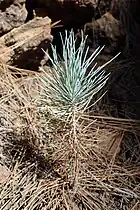 seedling in La Talleta, Tenerife, Canary Islands
seedling in La Talleta, Tenerife, Canary Islands
References
- Thomas, P. (2017). "Pinus canariensis". IUCN Red List of Threatened Species. 2017: e.T39603A84061236. doi:10.2305/IUCN.UK.2017-2.RLTS.T39603A84061236.en. Retrieved 2021-11-19.
- "Pinus canariensis C.Sm. ex DC.". The International Plant Names Index. Retrieved 2021-08-26.
- C.A.B. International (4 April 2002). Pines of Silvicultural Importance: Compiled from the Forestry Compendium, CAB International. CABI. p. 35. ISBN 978-0-85199-539-7.
- "Pinus canariensis C. Sm. ex DC.". Tropicos. Missouri Botanical Garden. Retrieved 2021-08-26.
- Gernandt, D. S.; López, G. G.; García, S. O.; Liston, A. (2005). "Phylogeny and classification of Pinus". Taxon. 54 (1): 29–42. doi:10.2307/25065300. JSTOR 25065300.
- Kasaplıgil, Baki (1977). "Ankara, Kızılcahamam yakınındaki Güvem köyü civarında bulunan son tersiyer kozalaklı-yeşil yapraklı ormanı" [A Late-Tertiary Conifer-Hardwood Forest From the Vicinity of Güvem Village, Near Kızılcahamam, Ankara] (PDF). Bulletin of the Mineral Research and Exploration (in Turkish and English). Ankara: General Directorate of Mineral Research and Exploration. 88: 94–102.
- Fossil seed cones of Pinus L. (Sect. Pinus, subsect. Pinaster LOUDON, Sula group) from the late Neogene and early Pleistocene of Europe, Palaeontographica, Abteilung B: Palaeobotany, Palaeophytology Article Vol. 291, Issues 1–6: 131–164, September 2014 E. Schweizerbart’sche Verlagsbuchhandlung, Stuttgart, Germany - DOI:10.1127/palb/291/1994/131 by Zlatko Kvacek, Vasilis Teodoridi, Petr Mazouch and Paul Roiron
- "The most fire-resistant pine in the world • Forest Monitor". Forest Monitor. 9 January 2017. Retrieved 2022-09-23.
- Starexcursions; Starexcursions (26 December 2016). "The canary island pine resists fire: how is it possible?". StarExcursions. Retrieved 2022-09-23.
- https://nature.berkeley.edu/stephenslab/wp-content/uploads/2015/04/Molina-et-al.-Canary-Island-FH-FEM-10-16.pdf
- Clarke, P. J.; Lawes, M. J.; Midgley, J. J.; Lamont, B. B.; Ojeda, F.; Burrows, G. E.; Enright, N. J.; Knox, K. J. E. (January 2013). "Resprouting as a key functional trait: how buds, protection and resources drive persistence after fire". New Phytologist. 197 (1): 19–35. doi:10.1111/nph.12001. ISSN 0028-646X. PMID 23110592.
- "Símbolos de la naturaleza para las Islas Canarias" [Natural Symbols for the Canary Islands]. Ley No. 7/1991 of 30 April 1991 (in Spanish). Vol. 151. pp. 20946–20497 – via BOE.
